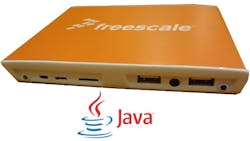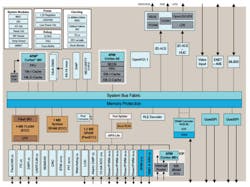I had a rather busy time at this year's 2014 Freescale Technology Forum down in Dallas. It seemed busier than EE Live at least on the floor where third party vendors were highlighting their latest Freecale wares along with Freescale's own new offerings.
Related Articles
- Development Kits Light Up The Internet Of Things
- Robots At FTF 2014
- Gallery: Modules At FTF 2014
- HyperBus Accelerates NOR Flash Storage
- Cortex-M4 Family Gets A Refresh
There was plenty to see including robots (see “Robots At FTF 2014”) and modules (see “Gallery: Modules At FTF 2014”) although I am going to have to write more about those because there were literally hundreds in all shapes and sizes with everything from Cortex-M0+ platforms up through multicore QorIQ modules.
I have already written about some of the new Kinetis K Series chips based on Arm's Cortex-M4 (see “Cortex-M4 Family Gets A Refresh”) as well as some of the higher end, 64-bit QorIQ LS2 series based on Freescale's Layerscape architecture (see “Cortex-A57 SoC Targets SDN/NFV Applications”).
Of course, these days the Internet of Things (IoT) seems to be dominating at least the marketing hype (see “Development Kits Light Up The Internet Of Things”) and there was plenty of IoT at FTF including Freescale's IoT Gateway (Fig. 1).
The IoT Gateway runs a dual core Cortex-A9 SoC, the i.MX6 Dual. The design can easily utilize a single or quad core i.MX6 as well. It has 802.11b/g/n Wi-Fi and Bluetooth 3.0 built-in. There is a four port USB hub that can handle interfaces for other communication protocols such as 802.15.4/ZigBee, Z-Wave and BLE (Bluetooth Low Energy) that is used in Apple's iBeacon (see “iBeacon Beckons").
The IoT Gateway is also a compact development system. There is a MicroSD slot for removeable flash storage and S/PDIF audio out and an line-in jack. Dual Gigabit Ethernet ports provide wired connectivity support. There is a DVID-D display port and an HDMI port so the device does not have to be used as a headless unit.
The platform can run a range of software but out of the box it has a Linux base along with Oracle's Java Embedded Suite (JES) based on Java SE Embedded (Fig. 2). The idea is to provide a standard hardware and software gateway platform for developers.
The Oracle Event Processing (OEP) system allows applications to filter and correlate events. The system also supports the ARM Sensinode NanoServices that provide directory lookup for IoT nodes that would communicate through the gateway. The platform also supports devices compatible with the Continua Health Alliance (see “An Alliance For Continued Good Health”).
The platform is great for any type of gateway or network appliance but it is obviously targeted at IoT. Oracle would like to be at the center of things but it is just one way of handling the job.
The other neat item at FTF was the MAC57D5xx (Fig. 3). This triple core microcontroller is designed for automotive instrumentation applications but it could just as easily be used in industrial or embedded applications that combine human interfaces with real time peripheral control such as motor control.
The MAC57D5xx supports up to two displays with a Vivante GC335 GPU designed for low overhead 2D displays. It also supports the automotive Ethernet 10/100 + AVB. The main apps core is the low power, Arm Cortex-A5 that can run Linux. The Cortex-M4 is designated as the vehicle processor. It has a singel precision floating point unit that can provide real time support. The tiny Cortex-M0+ has access to a limited set of peripherals and resources within the chip including an intelligent stepper motor subsystem.
There is 4 Mbytes of on-chip flash as well as 1 Mbyte of SRAM with ECC for applications and 1.3 Mbytes of SRAM with FlexECC for graphics. External flash can be access using SPI or Quad SPI but this chip is the first to utilize HyperBus (see “How HyperBus Delivers 330 Mbyte/s Using A Dozen Signals”). Spansion developed HyperBus for its NOR flash storage (see “HyperBus Accelerates NOR Flash Storage”).
All this actually just scratches the surface of what I saw this week so hopefully I will be able to let you know about the rest in the coming weeks.
About the Author
William Wong Blog
Senior Content Director
Bill's latest articles are listed on this author page, William G. Wong.
Bill Wong covers Digital, Embedded, Systems and Software topics at Electronic Design. He writes a number of columns, including Lab Bench and alt.embedded, plus Bill's Workbench hands-on column. Bill is a Georgia Tech alumni with a B.S in Electrical Engineering and a master's degree in computer science for Rutgers, The State University of New Jersey.
He has written a dozen books and was the first Director of PC Labs at PC Magazine. He has worked in the computer and publication industry for almost 40 years and has been with Electronic Design since 2000. He helps run the Mercer Science and Engineering Fair in Mercer County, NJ.
- Check out more articles by Bill Wong on Electronic Design
- Bill Wong on Facebook
- @AltEmbedded on Twitter



